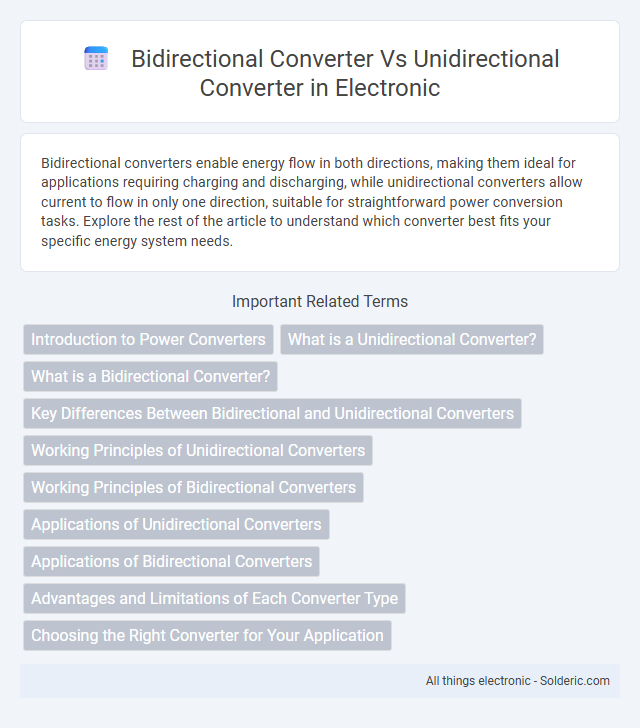Bidirectional converters enable energy flow in both directions, making them ideal for applications requiring charging and discharging, while unidirectional converters allow current to flow in only one direction, suitable for straightforward power conversion tasks. Explore the rest of the article to understand which converter best fits your specific energy system needs.
Comparison Table
| Feature | Bidirectional Converter | Unidirectional Converter |
|---|---|---|
| Power Flow | Two-way (input & output) | One-way (input to output only) |
| Applications | Battery charging/discharging, renewable energy systems | Power supply, voltage regulation |
| Complexity | Higher, due to dual direction control | Lower, simpler design |
| Cost | Generally more expensive | Generally less expensive |
| Control Method | Advanced control with bidirectional switching | Basic control with unidirectional switching |
| Efficiency | High efficiency in both directions, slightly lower overall | High efficiency in one direction |
| Examples | DC-DC bidirectional converters, inverter-chargers | DC-DC converters, AC-DC rectifiers |
Introduction to Power Converters
Power converters transform electrical energy from one form to another, playing a crucial role in renewable energy systems, electric vehicles, and industrial applications. Unidirectional converters allow energy flow in a single direction, typically from source to load, while bidirectional converters enable energy flow in both directions, supporting battery charging and discharging processes. The choice between bidirectional and unidirectional converters depends on system requirements such as energy storage integration and operational flexibility.
What is a Unidirectional Converter?
A unidirectional converter allows electrical energy to flow in only one direction, typically converting DC to AC or vice versa without the capability to reverse the power flow. Commonly used in applications like battery charging or power supplies, it ensures energy moves from the source to the load efficiently without feedback. Unlike bidirectional converters, unidirectional converters lack the functionality to feed energy back into the source, limiting their flexibility in energy management systems.
What is a Bidirectional Converter?
A bidirectional converter is an electronic device that allows power flow in both directions between two systems or components, enabling efficient energy transfer and regeneration. It is commonly used in applications like battery management systems, electric vehicles, and renewable energy systems to facilitate charging and discharging. Unlike a unidirectional converter, which only permits energy flow in a single direction, a bidirectional converter enhances system flexibility and energy efficiency by adapting to varying operational demands.
Key Differences Between Bidirectional and Unidirectional Converters
Bidirectional converters allow energy flow in both directions, enabling charging and discharging functions, while unidirectional converters only permit energy flow in a single direction, typically for power supply or conversion. Bidirectional converters are essential in applications such as energy storage systems or regenerative braking, providing greater flexibility and efficiency. Your selection depends on whether reversible power transfer or simple voltage conversion is required.
Working Principles of Unidirectional Converters
Unidirectional converters transfer energy in a single direction, converting DC to AC or modifying DC voltage levels without allowing reverse power flow. They typically operate using power semiconductor devices like diodes and transistors to control current flow in one path, enabling functions such as rectification or voltage regulation. The absence of feedback mechanisms or bidirectional switches distinguishes unidirectional converters from bidirectional converters, which facilitate energy flow in both directions for applications like battery charging and regenerative braking.
Working Principles of Bidirectional Converters
Bidirectional converters regulate energy flow in two directions, enabling charging and discharging operations between energy storage systems and loads or grids. They use switching devices controlled by pulse-width modulation (PWM) to invert and rectify current as needed, maintaining voltage and current balance. This capability contrasts with unidirectional converters, which allow energy flow in only one direction, limiting flexibility in applications like renewable energy and electric vehicles.
Applications of Unidirectional Converters
Unidirectional converters are primarily used in applications where power flows in a single direction, such as DC power supplies, battery charging systems, and renewable energy interfaces like solar panels feeding energy into the grid. These converters are favored for their simplicity, reliability, and cost-effectiveness in devices that do not require energy recovery or reverse power flow. Your system benefits from unidirectional converters when stable, one-way energy conversion is essential for efficient operation.
Applications of Bidirectional Converters
Bidirectional converters are essential in renewable energy systems, enabling energy flow both to and from storage devices like batteries, thus supporting grid stabilization and peak shaving. They play a critical role in electric vehicle (EV) applications by facilitating vehicle-to-grid (V2G) technology, allowing EV batteries to supply power back to the grid during high demand periods. Industrial energy management systems utilize bidirectional converters for load balancing and energy recovery, enhancing overall system efficiency and reliability.
Advantages and Limitations of Each Converter Type
Bidirectional converters enable energy flow in both directions, supporting applications like battery charging and regenerative braking, which improves system efficiency and flexibility. Unidirectional converters allow current flow in one direction, offering simpler design, lower cost, and higher reliability in applications where energy reversal is unnecessary. While bidirectional converters provide enhanced functionality, they often have higher complexity and increased control challenges compared to the straightforward architecture of unidirectional converters.
Choosing the Right Converter for Your Application
Selecting the appropriate converter depends on your power flow requirements and system complexity. Bidirectional converters enable energy transfer in both directions, ideal for applications like battery charging and regenerative braking, while unidirectional converters support power flow in only one direction, suitable for simpler, cost-sensitive designs. Efficiency, control complexity, and energy storage integration are key factors influencing the choice between bidirectional and unidirectional converters.
bidirectional converter vs unidirectional converter Infographic

 solderic.com
solderic.com